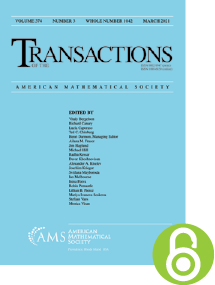Temperley–Lieb, Brauer and Racah algebras and other centralizers of $\mathfrak {su}(2)$
HTML articles powered by AMS MathViewer
- by Nicolas Crampé, Loïc Poulain d’Andecy and Luc Vinet PDF
- Trans. Amer. Math. Soc. 373 (2020), 4907-4932 Request permission
Abstract:
In the spirit of the Schur–Weyl duality, we study the connections between the Racah algebra and the centralizers of tensor products of three (possibly different) irreducible representations of $\mathfrak {su}(2)$. As a first step we show that the Racah algebra always surjects onto the centralizer. We then offer a conjecture regarding the description of the kernel of the map, which depends on the irreducible representations. If true, this conjecture would provide a presentation of the centralizer as a quotient of the Racah algebra. We prove this conjecture in several cases. In particular, while doing so, we explicitly obtain the Temperley–Lieb algebra, the Brauer algebra and the one-boundary Temperley–Lieb algebra as quotients of the Racah algebra.References
- Richard Brauer, On algebras which are connected with the semisimple continuous groups, Ann. of Math. (2) 38 (1937), no. 4, 857–872. MR 1503378, DOI 10.2307/1968843
- Joan S. Birman and Hans Wenzl, Braids, link polynomials and a new algebra, Trans. Amer. Math. Soc. 313 (1989), no. 1, 249–273. MR 992598, DOI 10.1090/S0002-9947-1989-0992598-X
- N. Crampe, L. Frappat, and L. Vinet, Bannai–Ito and Brauer algebras, J. Phys. A 52 (2019), 424001, and arXiv:1906.03936.
- Hendrik De Bie, Vincent X. Genest, Wouter van de Vijver, and Luc Vinet, A higher rank Racah algebra and the $\Bbb Z^n_2$ Laplace-Dunkl operator, J. Phys. A 51 (2018), no. 2, 025203, 20. MR 3741969, DOI 10.1088/1751-8121/aa9756
- Hendrik De Bie, Vincent X. Genest, and Luc Vinet, The $\Bbb {Z}_2^n$ Dirac-Dunkl operator and a higher rank Bannai-Ito algebra, Adv. Math. 303 (2016), 390–414. MR 3552530, DOI 10.1016/j.aim.2016.08.007
- J. J. Duistermaat and F. A. Grünbaum, Differential equations in the spectral parameter, Comm. Math. Phys. 103 (1986), no. 2, 177–240. MR 826863, DOI 10.1007/BF01206937
- Ya. A. Granovskiĭ and A. S. Zhedanov, Nature of the symmetry group of the $6j$-symbol, Zh. Èksper. Teoret. Fiz. 94 (1988), no. 10, 49–54 (Russian); English transl., Soviet Phys. JETP 67 (1988), no. 10, 1982–1985 (1989). MR 997934
- Plamen Iliev, Bispectral extensions of the Askey-Wilson polynomials, J. Funct. Anal. 266 (2014), no. 4, 2294–2318. MR 3150161, DOI 10.1016/j.jfa.2013.06.018
- Michio Jimbo, A $q$-analogue of $U({\mathfrak {g}}{\mathfrak {l}}(N+1))$, Hecke algebra, and the Yang-Baxter equation, Lett. Math. Phys. 11 (1986), no. 3, 247–252. MR 841713, DOI 10.1007/BF00400222
- Gustav Isaac Lehrer and Ruibin Zhang, On endomorphisms of quantum tensor space, Lett. Math. Phys. 86 (2008), no. 2-3, 209–227. MR 2465755, DOI 10.1007/s11005-008-0284-1
- G. I. Lehrer, and R. B. Zhang, A Temperley-Lieb analogue for the BMW algebra, arXiv:0806.0687.
- Paul Martin and Hubert Saleur, On an algebraic approach to higher-dimensional statistical mechanics, Comm. Math. Phys. 158 (1993), no. 1, 155–190. MR 1243720, DOI 10.1007/BF02097236
- Paul P. Martin and David Woodcock, On the structure of the blob algebra, J. Algebra 225 (2000), no. 2, 957–988. MR 1741573, DOI 10.1006/jabr.1999.7948
- A. Nichols, V. Rittenberg, and J. de Gier, One-boundary Temperley-Lieb algebras in the $XXZ$ and loop models, J. Stat. Mech. Theory Exp. 3 (2005), P03003, 30. MR 2140125
- S. Post and A. Walter, A higher rank extension of the Askey-Wilson Algebra, arXiv:1705.01860.
- G. Racah, Theory of complex spectra II, Phys. Rev. 62 (1942), 438–462.
- H. N. V. Temperley and E. H. Lieb, Relations between the “percolation” and “colouring” problem and other graph-theoretical problems associated with regular planar lattices: some exact results for the “percolation” problem, Proc. Roy. Soc. London Ser. A 322 (1971), no. 1549, 251–280. MR 498284, DOI 10.1098/rspa.1971.0067
- A. S. Zhedanov, “Hidden symmetry” of Askey-Wilson polynomials, Teoret. Mat. Fiz. 89 (1991), no. 2, 190–204 (Russian, with English summary); English transl., Theoret. and Math. Phys. 89 (1991), no. 2, 1146–1157 (1992). MR 1151381, DOI 10.1007/BF01015906
Additional Information
- Nicolas Crampé
- Affiliation: Institut Denis-Poisson CNRS/UMR 7013, Université de Tours, Université d’Orléans, Parc de Grandmont, 37200 Tours, France; and Centre de Recherches Mathématiques, Université de Montréal, P.O. Box 6128, Centre-ville Station, Montréal, Québec, H3C 3J7, Canada
- Email: crampe1977@gmail.com
- Loïc Poulain d’Andecy
- Affiliation: Laboratoire de mathématiques de Reims UMR 9008, Université de Reims Champagne-Ardenne, UFR Sciences exactes et naturelles, Moulin de la Housse BP 1039, 51100 Reims, France
- Email: loic.poulain-dandecy@univ-reims.fr
- Luc Vinet
- Affiliation: Centre de Recherches Mathématiques, Université de Montréal, P.O. Box 6128, Centre-ville Station, Montréal, Québec, H3C 3J7, Canada
- MR Author ID: 178665
- ORCID: 0000-0001-6211-7907
- Email: vinet@CRM.UMontreal.ca
- Received by editor(s): August 2, 2019
- Received by editor(s) in revised form: November 4, 2019
- Published electronically: March 27, 2020
- Additional Notes: The first and second authors were partially supported by Agence National de la Recherche Projet AHA ANR-18-CE40-0001.
The research of the third author was supported in part by a Discovery Grant from the Natural Science and Engineering Research Council (NSERC) of Canada. - © Copyright 2020 American Mathematical Society
- Journal: Trans. Amer. Math. Soc. 373 (2020), 4907-4932
- MSC (2010): Primary 16S20, 17B35
- DOI: https://doi.org/10.1090/tran/8055
- MathSciNet review: 4127866


